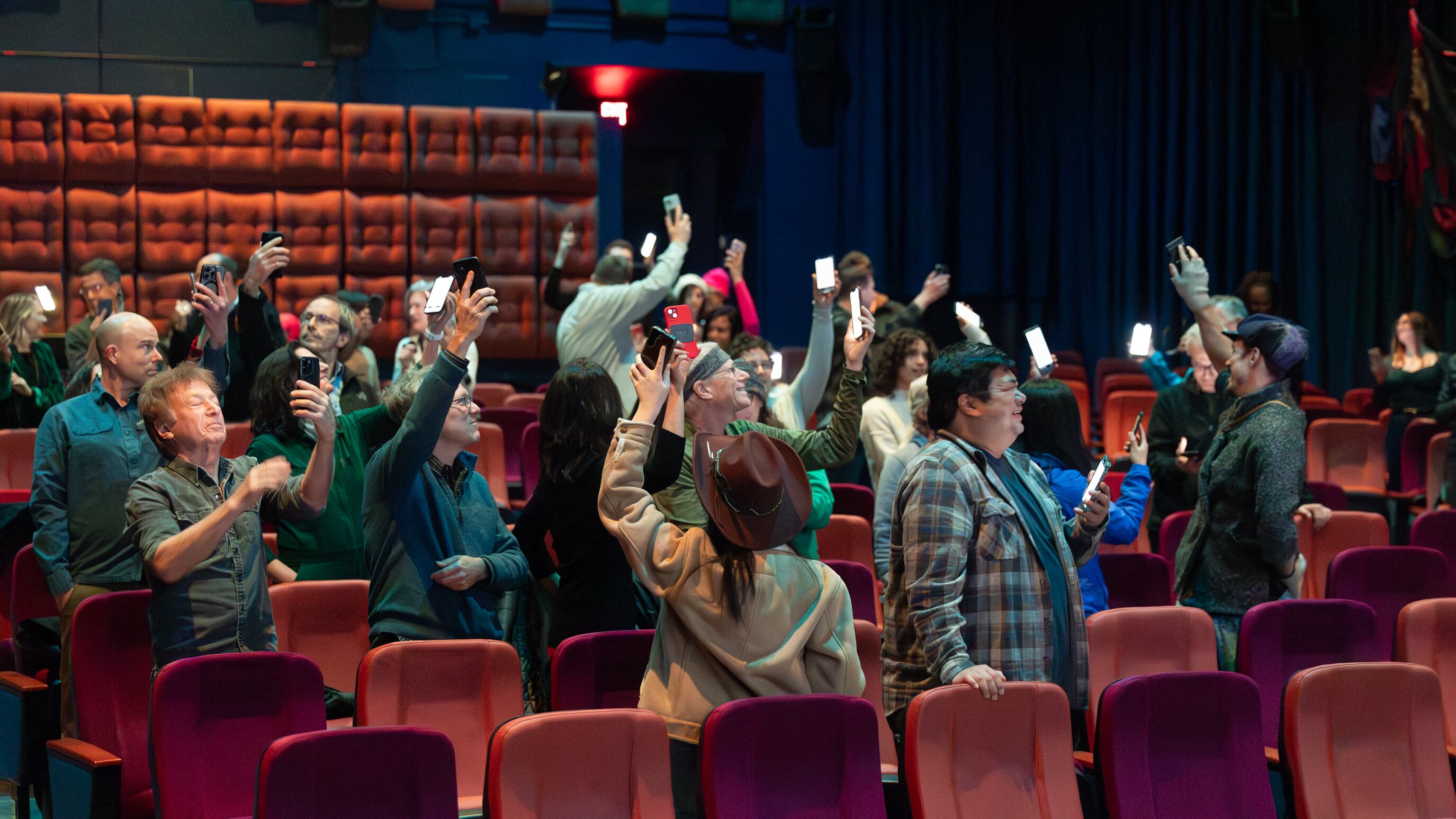Midway through a performance of the Smartphone Orchestra at PAM CUT’s Tomorrow Theater, a notification on my phone ordered me to make eye contact with a complete stranger for 20 seconds. I didn’t make it past one.
Had I failed at the ever-shifting art of socialization? Or was I simply discovering the complexities inherent in a performance that uses the very tools that divide us to connect us?
The Smartphone Orchestra was conjured up by Dutch multimedia impresario Steye Hallema, the project’s creative director (other key players include technical director/composer Eric Magnée, lead developer Hidde de Jong, and producer/designer Shea Elmore).
At multiple performances last weekend at the Tomorrow Theater, Hallema unleashed the Smartphone Orchestra on Portland, styling himself as a high priest of human connection who maintains a turbulent bond with his chosen instrument.
Hearing “smartphone” and “orchestra” in the same sentence is enough to make Luddite audiences crawl into a dank cavern and pray for a return to the pre-Napster era. Yet Hallema’s fusion of high-tech melodies and old-school icebreakers works as an intellectual provocation, daring the audience to challenge the basis of its existence.
At the April 6 event I attended, Hallema performed two pieces, “Music for Smartphones 3″ and “Emoji,” though the line between performance and participation swiftly blurred.
For “Music for Smartphones 3,” we were instructed to take out our phones and go to smartmob.io (the site is active even when a performance isn’t happening, but all you’ll hear during off hours is applause). Our devices then became synchronized, each playing a part of a piece of music akin to the gentle, yearning ambience of Christopher Bear and Daniel Rossen’s score for the film Past Lives.
As you listened, you never knew when your phone might fall silent and when it might pluckily join the chorus with a xylophonelike ping! The music seemed to surge from phone to phone like a wave, delivering a giddy thrill each time yours took its humble place in the vast ocean of sound
Amid this wonderment, Hallema expressed sincere horror at the omnipresence of smartphones. Describing schoolyards filled with screen-obsessed students, he could barely contain his despair: “It’s bad.”
That sentiment set the stage for “Emoji,” which is engineered to combat passivity. Unlike “Music for Smartphones 3,” “Emoji” allows you to alter the sound of the music by tapping characters on your screen (when I picked the laughing emoji, my phone emitted an unearthly cackle).
Making good on his philosophy of “telling stories with an audience instead of to them,” Hallema then paired us off for a game that required us to mimic emojis with our faces—and our partner to guess which one we were imitating.
I was atrocious at this, as were many others. “I’m too competitive,” one partner told me glumly, sounding genuinely troubled by his failure to match my ludicrous expressions with equally ludicrous cartoons of human emotion (does anyone know what the purple “Happy Devil” emoji is supposed to signify?).
While we spent most of the evening looking at screens, it’s notable that the Smartphone Orchestra forced us to vacate our cushy seats and interact with our compatriots—like the young man who told me, prodded by a conversation prompt, that he was proud of himself for socializing.
Given Hallema’s stated desire to both utilize and criticize the presence of technology in our lives, it makes sense that the best part of the Smartphone Orchestra wasn’t the smartphones, but those who wielded them. Perhaps the point of the enterprise is to inspire people to rebel—like the woman who defiantly announced to the audience that she would be attending a subsequent performance without using her phone.
I enjoyed myself too much to openly revolt, even though I was troubled by the distinction between telling stories “with” instead of “to.” Even without the sheen of interactivity, to be moved or to interpret is to participate in a way that is as meaningful as it is unquantifiable. Just ask anyone who enjoys swimming through the ripples of Handel’s “Water Music” or has found the pulse of Vangelis’ Chariots of Fire score propelling their every footstep.
What Hallema seems to be seeking is something equally mysterious: a truce between futurism and nostalgia. Those are the terms he has set for the Smartphone Orchestra and those are the terms it fulfills, allowing for the intriguing imperfections that technology often seeks to eradicate.
At the end of “Music for Smartphones 3,” audiences were given the option of using their phone to produce a clapping noise. That the applause never quite synced up was a feature, not a bug. Or, perhaps, a spark of human mischief.
